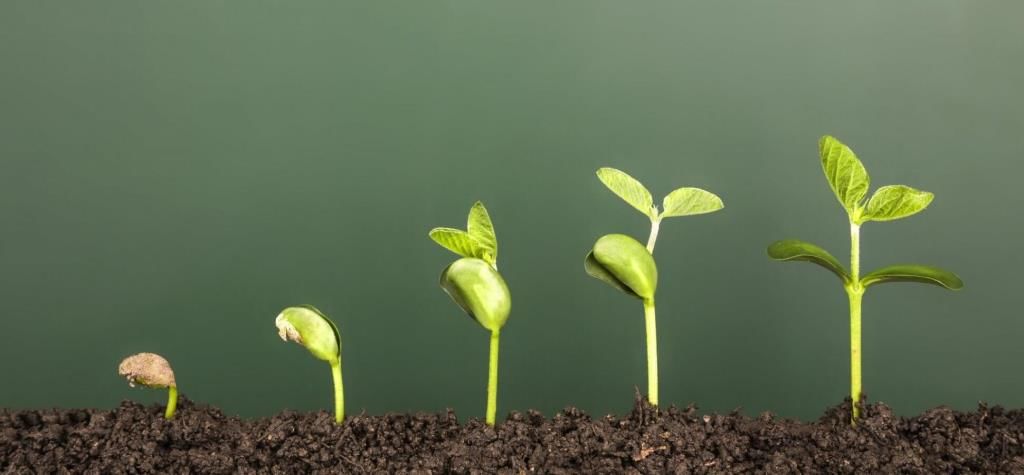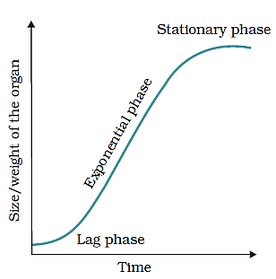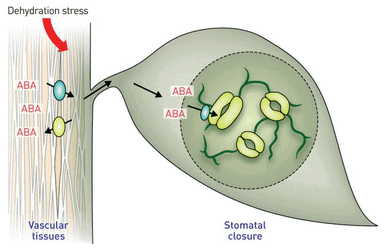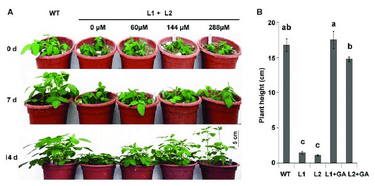NCERT Solutions Class 11 Biology Chapter 15 - Plant Growth & Development
Q1: Define growth, differentiation, development, de-differentiation, redifferentiation, determinate growth, meristem, and growth rate.
Ans: (a) Growth: It is an irreversible and permanent process, accomplished by an increase in the size of an organ or organ parts or even of an individual cell. Growth in Plants
Growth in Plants
(b) Differentiation: It is a process in which the cells derived from the apical meristem (root and shoot apex) and the cambium undergo structural changes in the cell wall and the protoplasm, becoming mature to perform specific functions.
(c) Development: It refers to the various changes occurring in an organism during its life cycle – from the germination of seeds to senescence.
(d) De-differentiation: It is the process in which permanent plant cells regain the power to divide under certain conditions.
(e) Re-differentiation: It is the process in which de-differentiated cells become mature again and lose their capacity to divide.
(f) Determinate growth: It refers to limited growth.
Example: Animals and plant leaves stop growing after having reached maturity.
(g) Meristem: In plants, growth is restricted to specialized regions where active cell divisions take place. Such a region is called meristem.
There are three types of meristems: Apical meristem, Lateral meristem, and Intercalary meristem.
(h) Growth rate: It can be defined as increased plant growth per unit time.
Q2: Why is not anyone parameter good enough to demonstrate growth throughout the life of a flowering plant?
Ans: Growth is a consequence of the increase in the quantity of protoplasm. Measuring the protoplasmic growth includes several parameters, to name a few – increase in height, weight, number of cells, fresh tissue sample, length, area, volume, etc. Hence it is difficult to demonstrate any one parameter of growth throughout the life of a flowering plant.  Measurement of Plant
Measurement of Plant
Q3: Describe briefly:
(a) Arithmetic growth
(b) Geometric growth
(c) Sigmoid growth curve
(d) Absolute and relative growth rates
Ans: (a) Arithmetic growth: In arithmetic growth, one of the daughter cells continues to divide, while the other differentiates into maturity. The elongation of roots at a constant rate is an example of arithmetic growth.
It can be mathematically expressed as follows:
Lt = Lo + rt
Lt = length of time ‘t’
Lo = length at time ‘zero’
r = growth rate/elongation per unit time (b) Geometric growth: Geometric growth is characterized by slow growth in the initial stages and rapid growth during the later stages. The daughter cells derived from mitosis retain the ability to divide but slow down because of a limited nutrient supply.
(b) Geometric growth: Geometric growth is characterized by slow growth in the initial stages and rapid growth during the later stages. The daughter cells derived from mitosis retain the ability to divide but slow down because of a limited nutrient supply.

(c) Sigmoid growth curve: The growth of living organisms in their natural environment is characterized by an S-shaped curve called a sigmoid growth curve. This curve is divided into three phases – lag phase, log phase, or exponential phase of rapid growth, and stationary phase.

(d) Absolute and relative growth rates: Absolute growth rate refers to the measurement and comparison of total growth per unit time. Relative growth rate refers to the growth of a particular system per unit of time, expressed on a common basis.
Q4: List five main groups of natural plant growth regulators. Write a note on the discovery, physiological functions, and agricultural/horticultural applications of any one of them.
Ans: Plant growth regulators are the intercellular intrinsic factors (chemical substances) that are responsible for the growth and development of plants.
The five main groups of natural plant growth regulators (PGR) are as follows:
(i) Auxins
(ii) Gibberellins
(iii) Cytokinins
(iv) Abscisic acid
(v) Ethylene
These PGRs are synthesized in different plant parts, governing various differentiation and developmental events that take place in the life cycle of a plant.
Auxins
- Discovery
The first observations regarding the effects of auxins were made by Charles Darwin and Francis Darwin, wherein they saw the coleoptiles of canary gross bending toward a unilateral source of light.
It was concluded after a series of experiments that some substance produced at the tip of coleoptiles was responsible for the bending. Finally, this substance was extracted as auxins from the tips of coleoptiles in oat seedlings. - Physiological functions
(i) They control plant cell growth.
(ii) They cause the phenomenon of apical dominance.
(iii) They control division in the vascular cambium and xylem differentiation.
(iv) They induce parthenocarpy and prevent abscission of leaves and fruits. - Horticultural applications
(i) They are used as the rooting hormones in stem cuttings.
(ii) 2-4 D is used weedicide to kill broadleaf, dicotyledonous weeds.
(iii) They induce parthenocarpy in tomatoes.
(iv) They promote flowering in pineapple and litchi.
Q5: Why is Abscisic acid also known as stress hormone?
Ans: Abscisic acid is called stress hormones as it induces various responses in plants against stress conditions:
- It increases the tolerance of plants toward various stresses.
- It induces the closure of the stomata during water stress.
- It promotes seed dormancy and ensures seed germination during favorable conditions.
- It helps seeds withstand desiccation.
- It also helps in inducing dormancy in plants at the end of the growing season and promotes the abscission of leaves, fruits, and flowers.
 Stress Hormone
Stress Hormone
Q6: 'Both growth and differentiation in higher plants are open'. Comment.
Ans: Growth and development in higher plants are referred to as being open. This is because various meristems, having the capacity for continuously dividing and producing new cells, are present at different locations in these plant bodies.
Q7: ‘Both a short day plant and a long day plant can flower simultaneously in a given place’. Explain.
Ans:
- The flowering response in short-day plants and long-day plants is dependent on the duration for which these plants are exposed to light.
- The short-day plant and long-day plant can flower at the same place, provided they have been given an adequate photoperiod.
Q8: Which one of the plant growth regulators would you use if you are asked to:
(a) Induce rooting in a twig
(b) Quickly ripen a fruit
(c) Delay leaf senescence
(d) Induce growth in axillary buds
(e) ‘Bolt’ a rosette plant
(f) Induce immediate stomatal closure in leaves.
Ans:
(a) Induce rooting in a twig – Auxins
(b) Quickly ripen a fruit – Ethylene
(c) Delay leaf senescence – Cytokinins
(d) Induce growth in axillary buds – Cytokinins
(e) ‘Bolt’ a rosette plant – Gibberellic acid
(f) Induce immediate stomatal closure in leaves – Abscisic acid
Q9: Would a defoliated plant respond to the photoperiodic cycle? Why?
Ans: No, a defoliated plant will not respond to the photoperiodic cycle. This is because the leaves are the sites of perception of dark or light duration. Hence, if leaves were not present, plants would not respond to light.
Q10: What would be expected to happen if:
(a) GA3 is applied to rice seedlings.
(b) Dividing cells stop differentiating.
(c) A rotten fruit gets mixed with unripe fruits.
(d) You forget to add cytokinin to the culture medium.
Ans:
(a) If GA3 is applied to rice seedlings, then the rice seedlings will exhibit internode elongation and increase in height.
 GA3 effect on plants(b) If dividing cells stop differentiating, then the plant organs such as leaves and stem will not be formed. The mass of undifferentiated cells is called a callus.
GA3 effect on plants(b) If dividing cells stop differentiating, then the plant organs such as leaves and stem will not be formed. The mass of undifferentiated cells is called a callus.
(c) If a rotten fruit gets mixed with unripe fruits, then the ethylene produced from the rotten fruits will hasten the ripening of the unripe fruits.
(d) If you forget to add cytokinin to the culture medium, then cell division, growth, and differentiation will not be observed.
Old NCERT Solution
Q1: What do you understand by photoperiodism and vernalisation? Describe their significance.
Ans:
- Photoperiodism: can be termed as the response of plants to periods of day/night. It is theorized that the hormonal substance that is responsible for flowering, is formed in the leaves which subsequently migrates to the shoot apices and alters them into flowering apices. This process of photoperiodism helps in studying the response of flowering in different crop plants when the duration of exposure of light is considered.
- Vernalisation: is the phenomenon where the process of flowering in some plants is either quantitatively or qualitatively dependent on exposure to lower temperatures. In particular, it refers to promoting the flowering process by a period of lower temperatures. The process prevents precocious reproductive development late in the growing season which thereby enables the plant to have sufficient time to attain maturity.
|
150 videos|399 docs|136 tests
|
FAQs on NCERT Solutions Class 11 Biology Chapter 15 - Plant Growth & Development
| 1. What are the different stages of plant growth and development? |  |
| 2. How do plants respond to environmental factors during their growth and development? |  |
| 3. What is photoperiodism and how does it affect plant growth and development? |  |
| 4. How do hormones regulate plant growth and development? |  |
| 5. What are some common factors that can affect plant growth and development negatively? |  |






















